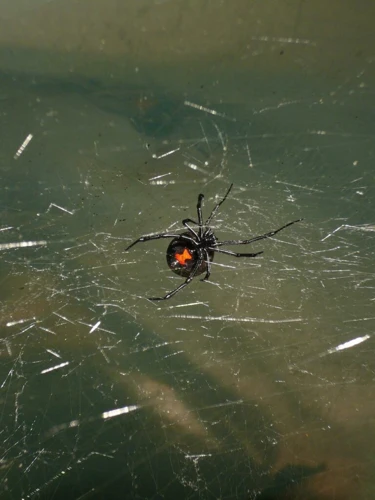As a lover of spiders and their place in our ecosystem, I was perplexed to learn that not much is known about the distribution of Black Widow Spiders across Asia. These venomous arachnids are notorious for their dangerous bite and their striking appearance, yet detailed information about their presence in various regions of Asia was hard to come by. In this article, we will examine the different types of Black Widow Spiders found in Asia, their distribution across the continent, as well as their identification, behavior, and treatment in case of a bite. We will also look at ways to prevent and control their presence in our homes and surroundings. Let’s delve deeper into the mysterious world of these elusive spiders.
Types of Black Widow Spiders in Asia
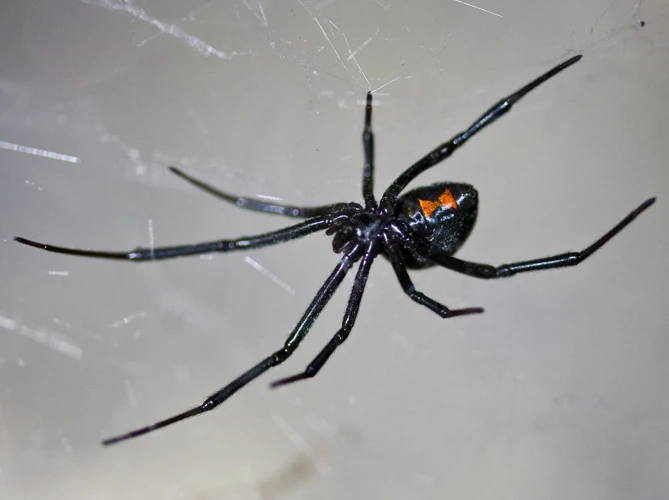
The presence of black widow spiders in Asia is quite fascinating. Different species of black widow spiders have been found in various parts of Asia. These spiders belong to the genus Latrodectus, which is known for its venomous nature. Latrodectus spiders are distributed across Africa, Asia, Australia, and North and South America. Today, we are going to explore the types of black widow spiders found in Asia and how they are distributed. We’ll also discuss the identification of these spiders, their behavior, and diet, as well as methods for preventing and controlling their presence. To gain a better understanding of black widow spiders, it may be useful to compare them to their counterparts in other parts of the world. Visit our articles on the presence of Black Widow spiders in South America or Black Widow spiders in North America for further information.
1. Latrodectus hasseltii
One of the most poisonous types of black widow spiders found in Asia is Latrodectus hasseltii, commonly known as the redback spider. These spiders are found predominantly in Australia and some parts of Southeast Asia. The redback spider’s body is just half an inch long, but females can grow up to 1 inch in size. They are recognizable by their jet-black body with a prominent red stripe on their abdomen.
Redback spiders prefer to build their webs in undisturbed areas such as sheds, garages, and underneath outdoor furniture. Their webs have a distinctive messy look, making them easy to spot. These spiders are very adaptable and can survive in a variety of habitats such as forests, grasslands, and suburban areas. They are also known to thrive in areas with human activity, making them a common nuisance.
The redback spider is a carnivorous spider, and they feast on a variety of insects including beetles, cockroaches, and caterpillars. They use their venom to paralyze their prey before encasing it in silk and consuming it. Their venom is also potent enough to cause harm to humans if bitten.
According to mapping-black-widow-spiders, the redback spider is one of the common black widow spiders in Australia, and their bite can cause symptoms such as sweating, muscle spasms, and nausea. In severe cases, it can even cause death. However, with proper medical attention, fatalities can be avoided.
Conservation of black widow spiders, including the redback spider, is vital to ensure their survival. Their habitats are under threat due to habitat destruction and human activity. Conservation efforts, coupled with awareness campaigns, can help protect these fascinating creatures and prevent their decline.
2. Latrodectus lugubris
Latrodectus lugubris, commonly known as the Mediterranean black widow, is found in the Mediterranean area and parts of Asia. The species belongs to the family Theridiidae and is a close relative of the Latrodectus hesperus, the western black widow found in North America.
Physical Appearance: L. lugubris is generally smaller in size compared to other black widows, with females measuring up to 2 cm and males being only around 6 mm long. Females have the characteristic black body with an hourglass-shaped red or orange marking on the abdomen. In contrast, males have yellow and red stripes on their abdomens and a lighter body color.
Web Pattern: The webs of L. lugubris are chaotic and disorganized, making them more challenging to spot than other black widow spiders. They typically spin webs in dark corners, crevices, or under rocks, rather than in open fields.
Despite their venomous nature, black widows like L. lugubris have vital ecological roles in controlling insect populations in their respective habitats. Unfortunately, introducing non-native species or destroying habitats can have adverse effects on these spiders, just like any other animal species. Learn more about habitats of black widow spiders and how they play a part in maintaining a delicate ecological balance.
It is crucial to avoid disturbing these spiders by being careful when moving or rearranging outdoor objects to steer clear of their webs. Knowing where they thrive, such as in suburban areas, can help prevent bites and promote coexistence. If you suspect you have been bitten by a black widow spider, seek medical attention right away. Learn more about fatalities due to black widow spider bites and the importance of prompt and proper treatment.
3. Latrodectus israelensis
Latrodectus israelensis, also known as the Israeli black widow spider, is a species of venomous spider found in parts of Asia. This spider species is small in size, with females being larger than males. The females have a shiny black body with a characteristic red hourglass-shaped marking on the underside of the abdomen. Males, on the other hand, have a brownish coloration.
| Common Name | Scientific Name | Physical Description |
|---|---|---|
| Israeli black widow spider | Latrodectus israelensis | Shiny black body with a red hourglass-shaped marking on the underside of the abdomen |
Like other black widow spiders, Latrodectus israelensis feeds on a varied diet, consisting primarily of insects but also including other spiders. They are typically found in secluded habitats such as under rocks, logs, or debris. Due to their elusive nature, encounters with this spider species are rare, and they are not considered a significant threat to humans.
Despite this, it is essential to exercise caution around this spider species as their venom can be highly toxic and potentially lethal to humans. The bite of Latrodectus israelensis can cause symptoms such as muscle cramps, pain, and abdominal discomfort. If bitten by this spider species, it is important to seek medical attention immediately.
To prevent encounters with this spider species and other black widow spiders, it is essential to take measures such as wearing gloves and protective clothing when working outdoors, shaking out clothes and shoes before wearing them, and keeping outdoor areas free of debris or clutter.
Latrodectus israelensis is a species of black widow spider found in parts of Asia. Although they are not considered a significant threat to humans, it is important to exercise caution when encountering this spider species due to their venomous nature. To learn more about black widow spiders, check out our article on where black widow spiders thrive and the impact of habitat destruction or how they adapt to suburban areas in suburban black widow spiders.
4. Latrodectus tredecimguttatus
One of the black widow spider species found in Asia is Latrodectus tredecimguttatus, also known as the Mediterranean black widow spider. This species is commonly found in the Mediterranean region and Central Asia. It is the most widespread of all the black widow species, occupying a range of habitats from forests to meadows.
Here are some key features of the Latrodectus tredecimguttatus species:
- The female Latrodectus tredecimguttatus has a distinctive hourglass-shaped mark on its abdomen, which is a characteristic feature of black widow spiders.
- The abdomen is black and somewhat spherical in shape.
- The legs are black and shiny, and the male may have red or white spots on the dorsal area of the abdomen.
- Their size can range from 12-15 millimeters for females and 4-6 millimeters for males.
The Mediterranean black widow spider feeds on a variety of prey, including small invertebrates such as beetles, flies, and ants. Their venom is also highly toxic and may cause muscle pain, spasms, and other symptoms. In extreme cases, a bite from the Latrodectus tredecimguttatus species may result in death, although this is rare.
While there are no specific conservation efforts for black widow spiders, it’s important to note that they play an important role in controlling populations of other insects. It is important to respect and protect their natural habitats. To learn more about the conservation of black widow spiders, visit our article on conservation efforts for black widow spiders. For more information on other black widow species around the world, check out our article on global black widow spiders.
Distribution across Asia
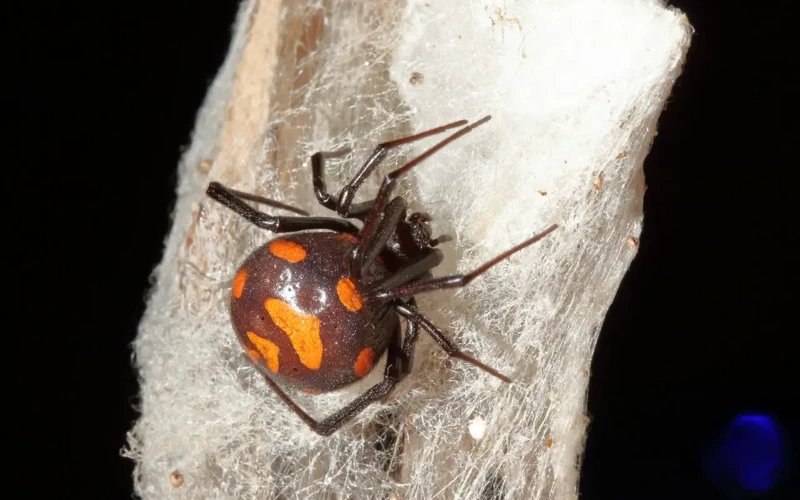
As we delve deeper into the world of black widow spiders, it’s important to understand their distribution across Asia. The geographical expanse of the continent accounts for a wide range of habitats where these venomous spiders can thrive. From the deserts of the Middle East to the tropical regions of Southeast Asia, black widow spiders have adapted to diverse environments and are found in a variety of countries. Let’s explore the spatial spread of these arachnids and gain insight into their regional prevalence and behavior.
1. China
China is one of the countries in Asia with a significant distribution of black widow spiders. This country is home to various species of black widow spiders, including the Latrodectus tredecimguttatus, Latrodectus pallidus, and Latrodectus mactans.
| Species | Range of Distribution |
|---|---|
| Latrodectus tredecimguttatus | Found throughout China, mainly in Northern and Western regions |
| Latrodectus pallidus | Primarily found in Northern and Northwestern China |
| Latrodectus mactans | Found in various regions of China, particularly in the Southern and Central areas |
The Latrodectus tredecimguttatus is the most widespread species and can be found throughout the country, especially in the northern and western regions. Meanwhile, Latrodectus pallidus is commonly found in the northern and northwestern region, while Latrodectus mactans, a close relative of the black widow spider, is distributed in various regions, particularly in the south and central areas.
It is essential to note that black widow spider habitats in China are mainly in rural areas and are often found in fields, orchards, and gardens. They are also known to thrive in piles of rubbish, woodpiles, and crevices between rocks.
It is important to keep an eye out for black widow spiders in China, particularly in rural areas. Their venom can be dangerous, and although they generally avoid humans, they may bite when threatened. If bitten, seeking professional medical attention immediately is crucial in preventing severe symptoms and complications.
2. Japan
Japan is one of the countries in Asia where black widow spiders can be found. The spiders are primarily distributed in the central regions of the country and are commonly found in urban and suburban areas. Black widow spiders in Japan are typically of the Latrodectus hasseltii species and are recognizable by their shiny black color and distinctive red hourglass markings on their undersides.
Black widow spiders in Japan prefer to create their webs in dark, hidden places such as in cracks, crevices, and inside cluttered areas. They are most active during the warmer months, with the highest numbers of bites typically occurring in May and June.
If you live in Japan and wish to prevent black widow spider infestations in your home, there are some steps you can take. Keeping your home clean and tidy, reducing clutter, and making sure all potential entry points are sealed can help reduce the chance of spider infestations. If you do encounter a black widow spider, it is best to avoid provoking it and call a professional pest control service for assistance.
In the rare instance that you are bitten by a black widow spider in Japan, it is important to seek medical attention immediately. Symptoms of a black widow spider bite may include throbbing pain, muscle cramps, abdominal pain, and sweating. Treatment typically involves administering antivenom and providing supportive care for relief of symptoms.
3. India
India is one of the countries where black widow spiders can be found. These venomous spiders are commonly found in the southern part of India. The main species of black widow spider found in India is Latrodectus hasseltii, which is also known as the Australian redback spider.
In India, black widow spiders are mostly found in warm and humid areas such as gardens, fields, and forests. They often make their webs in dry and undisturbed areas like tree hollows, rock crevices, and the underside of rocks.
The distribution of black widow spiders in India extends from the southern state of Tamil Nadu to the northern state of Uttar Pradesh. They can also be found in other states like Andhra Pradesh, Maharashtra, and Goa.
Though black widows are not considered a serious threat to humans in India, their bite can cause severe pain, muscle cramps, and spasms. It is essential to identify the symptoms of black widow spider bites. Common symptoms include intense pain at the bite site, sweating, nausea, abdominal pain, and muscle pain. If not treated properly, black widow spider bites can also lead to respiratory failure.
To prevent black widow spider bites, it is essential to take some precautions. One of the best measures to control black widow spiders in India is to keep the living spaces clean and free of clutter. Seal all the cracks and gaps in doors and windows using caulk or weather stripping. Always wear gloves and shoes while working outside. It is advisable to seek medical attention immediately if bitten by any venomous spider.
Black widow spiders can be found in India, particularly in the southern states. These venomous spiders can pose a risk to humans if not identified and treated immediately. Awareness about the behavioral patterns, the identification, and the preventive measures can help minimize the chances of encountering these deadly creatures.
4. Russia
Russia is a vast country that spans across multiple climatic zones, making it a suitable habitat for several species of black widow spiders. The prevalence of black widow populations in Russia varies from region to region, but they are generally found in the southern parts of the country.
Latrodectus tredecimguttatus is the species of black widow spider that is commonly found in Russia. These spiders typically live in dry, warm regions and can be found in areas such as urban parks, gardens, and rural landscapes. They are also known to inhabit abandoned buildings and other man-made structures.
To understand the distribution of black widows in Russia, let’s take a look at the table below:
| Region | Prevalence |
|---|---|
| Krasnodar Krai | High |
| Rostov Oblast | High |
| Stavropol Krai | Medium |
| Volgograd Oblast | Low |
| Astrakhan Oblast | Low |
As you can see from the table, the Krasnodar Krai and Rostov Oblast regions in southern Russia have a high prevalence of black widow spiders. The Stavropol Krai region, which is also in the south but further east, has a medium prevalence. Meanwhile, the Volgograd Oblast and Astrakhan Oblast regions in the southeast have a low prevalence of black widows.
It’s important to note that while black widow spiders are venomous, they generally only attack humans in self-defense. However, it’s still best to exercise caution when exploring areas where black widow spiders are known to live.
Black widow spiders can be found in various parts of Russia, with the highest prevalence in the southern regions of Krasnodar Krai and Rostov Oblast. It’s important to be aware of their presence and take necessary precautions to avoid unwanted interactions.
5. Middle East
The Middle East region includes various countries, and black widow spiders are found in several of them. Some of the countries in the Middle East where black widow spiders are found include Saudi Arabia, Iran, and Israel, among others.
In Saudi Arabia, the black widow spider is known as “Abu Zabal,” and it is found in many regions, including the eastern and central regions. The bite of this spider is known to cause intense pain and discomfort, and in some cases, it can be life-threatening for people who are allergic. It is recommended to seek medical attention immediately in case of a spider bite.
In Iran, the black widow spider is found in many regions, including the northern and northeastern parts of the country. The spider is known to make its webs in dark and damp areas such as basements and cellars. The bite of the black widow spider can cause symptoms such as severe muscle cramps, sweating, and difficulty breathing.
In Israel, black widow spiders are commonly found in the southern parts of the country, particularly in the Negev desert. The spiders are known to hide in crevices and holes in rocks and walls, and they are most active during the warmer months. It is important to be cautious when hiking or camping in areas where black widow spiders are known to inhabit.
While black widow spiders are not as widespread in the Middle East as they are in some other regions such as North America, caution should still be exercised when in areas where they are known to live. Taking steps to avoid contact with the spiders, such as wearing appropriate clothing and footwear, can help prevent spider bites and keep individuals safe from harm.
Identification
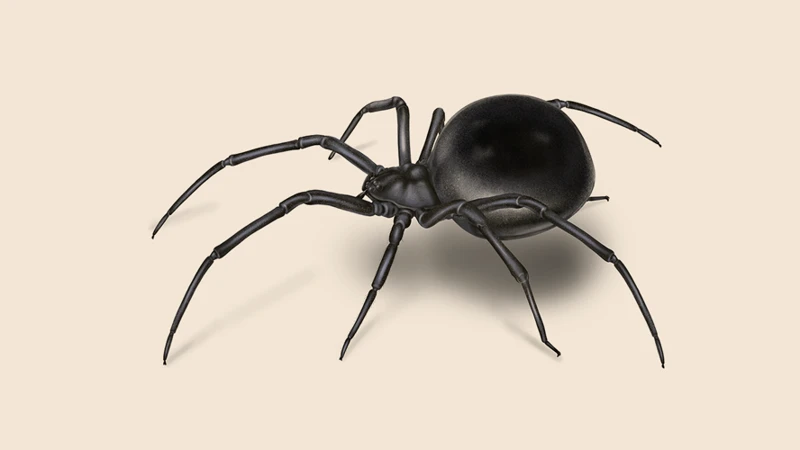
One of the most important things when it comes to dealing with black widow spiders is being able to effectively identify them. Proper identification is crucial, as it allows individuals to take the necessary precautions and respond accordingly if they encounter one of these potentially dangerous creatures. In this section, we will explore the different physical characteristics and web patterns that can help identify black widow spiders in Asia. Let’s delve into the details and learn more about how to spot these arachnids.
1. Physical Appearance
When it comes to identifying black widow spiders, their physical appearance is one of the key factors to rely on. Some of the characteristics that stand out most are:
- Size: Female black widow spiders are larger than males, averaging around 1.5 inches in length while males are around half the size.
- Color: The most common black widow species seen in Asia are usually black or dark brown in color. Females may feature a bright red or orange “hourglass” shape on their abdomen, while males may have yellow or white spots on their backs.
- Abdomen Shape: Black widow spiders have a round, bulbous abdomen that is much larger than their head and thorax.
- Legs: Their legs are thin and long, with spines and hair-like structures covering them.
It’s worth noting that the specific physical characteristics of black widow spiders may vary slightly depending on species and region. For example, the Latrodectus hasseltii species found in some parts of Asia may have slightly different markings on its abdomen than other Asian black widow species. Despite these differences, the physical appearance of black widow spiders is typically distinctive enough to recognize the species as a whole.
2. Web Pattern
When it comes to identifying a black widow spider’s web pattern, there are some distinct characteristics to look out for. These spiders usually spin their webs in areas where they can easily catch their prey such as in corners, crevices, and holes. The web pattern of black widow spiders is typically messy and irregular, unlike the exquisite webs spun by many other spider species.
Black widow spider webs are made up of tangled silk that criss-crosses in all directions. They tend to be asymmetrical and have many non-sticky threads. The silk is laid in a messy, tangled manner, with no clear geometric design or symmetry. This makes it challenging to determine the location of the spider, as the web catches prey from all directions.
When the spider moves, it leaves a zigzagged web pattern, called a “decorative band.” This band is distinctive and is made up of white silk that contrasts with the rest of the web. It serves as both a camouflage and a warning to animals that might inadvertently run into the web and alert the spider to their presence.
Black widow spider webs are very sticky and are composed of glued droplets produced by glands in the spider’s abdomen. The strands are highly adhesive and sticky, making it difficult for prey to escape, especially small insects. Once prey is caught, the spider will come out of hiding to wrap it in silk and deliver its venomous bite.
The messy and irregular web pattern of black widow spiders makes them easy to spot. However, it is advised not to approach or disturb their webs as this increases the risk of a spider bite which can be very painful and potentially harmful.
Behavior and Diet
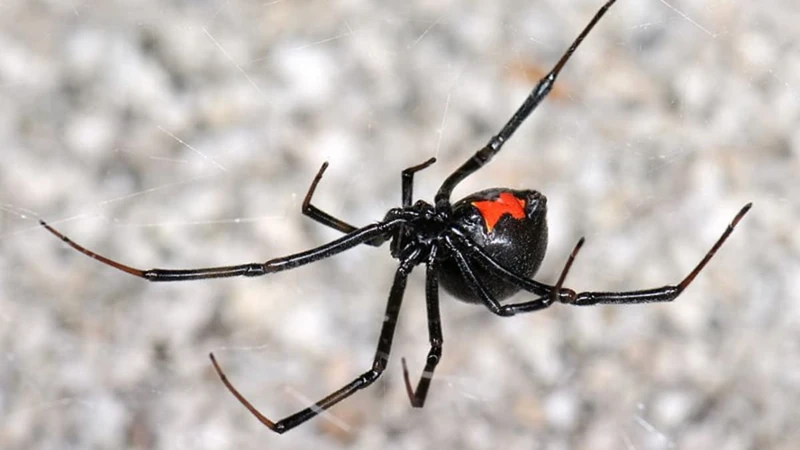
Black widow spiders are known for their solitary and aggressive nature. They are territorial and will defend their territory if they feel threatened. These spiders are nocturnal and prefer to hunt during the night, although they can also be seen during the day.
Diet
The primary diet of black widows consists of insects such as roaches, ants, and beetles. They also feed on other spiders, scorpions, and even small reptiles and mammals. The black widow spider’s diet is quite varied and diverse, and they are generally considered opportunistic hunters. They also play an important role in controlling the pest population.
Behavior
Black widows are known for their distinctive behavior and webbing patterns. They construct irregular webs in dark, secluded areas, such as rock crevices, under logs, and inside hollow trees or abandoned buildings. They prefer habitats that provide adequate shelter, like leaf litter, old woodpiles, and garden debris.
Black widows are not social creatures and prefer to be alone. They will attack and consume any prey that comes near their webs, using venom to overpower their prey. The venom of the black widow spider contains a neurotoxin that affects the nervous system of the victim, causing paralysis and eventually death.
During mating, males approach females and signal their presence by tapping the female’s web. After mating, females will lay up to 50 eggs at a time. The eggs are enclosed in a silken cocoon, which the female will guard fiercely.
Black widow spiders are solitary, territorial, and opportunistic hunters. They construct irregular webs in dark, secluded areas and will attack and consume any prey that comes near their webs. They play an important role in controlling the pest population, but their venom can be deadly to humans and pets. It is important to understand their behavior and diet to avoid encounters and stay safe.
Spider Bite and Treatment
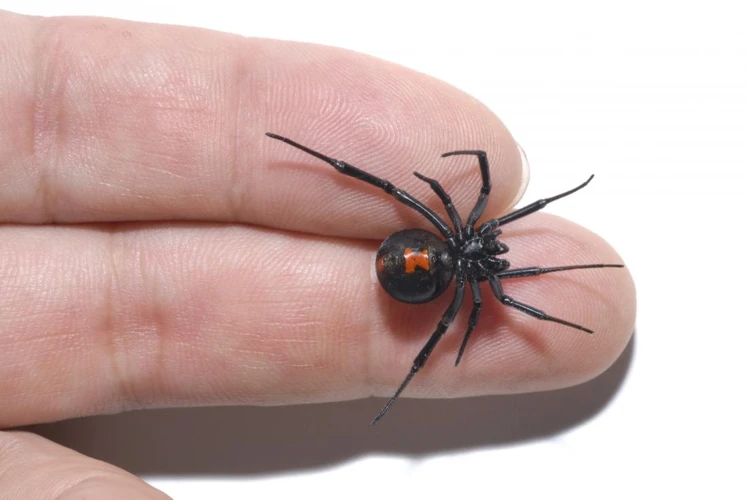
The bite of a black widow spider can be a concerning experience for anyone. These spiders are venomous, and their bites can be very painful and even life-threatening in certain cases. Thus, it’s essential to know how to identify the signs of a black widow spider bite and seek prompt treatment. In this section, we’ll take a closer look at the symptoms of a black widow spider bite and the treatment options available. Let’s dive in and learn how to handle this dangerous situation.
1. Symptoms
After being bitten by a black widow spider, symptoms can vary depending on the individual’s reaction and the amount of venom injected into the body. Here are some of the common symptoms:
- Sharp pain: The bitten area will feel a sharp, stinging pain, which can quickly spread to other parts of the body.
- Muscle cramps: The venom of a black widow spider can cause muscle cramps, particularly in the abdomen, chest, and back.
- Abdominal pain: Along with muscle cramps, it is common to feel abdominal pain, which can be severe.
- Sweating: Excessive sweating is among the most common symptoms of black widow spider bite and is one of the earliest symptoms to appear. It may be accompanied by other symptoms like nausea and tremors, especially in the legs.
- Numbness or tingling: The bite can cause numbness and tingling around the bitten area, which can then spread throughout the body. This is sometimes described as a crawling sensation under the skin.
- Increased blood pressure: In some cases, black widow spider bites can cause a rapid increase in blood pressure, leading to heart palpitations, dizziness, and fainting.
- Difficulty breathing: Although it is rare, in severe cases, black widow spider bite can cause difficulty breathing, muscle weakness, and convulsions.
If you experience any of these symptoms after being bitten by a black widow spider, it is important to seek medical attention immediately. Early treatment can prevent the venom from spreading throughout your body and causing further damage. Do not hesitate to contact your doctor or local emergency services.
2. Treatment
One of the primary methods for treating a black widow spider bite is the administration of antivenom. Antivenom works by neutralizing the venom in the bloodstream, reducing the severity of symptoms and preventing the bite from causing further damage.
Here is a table summarizing the common treatments for black widow spider bites:
| Treatment | Description |
|---|---|
| Antivenom | Administered intravenously or intramuscularly to neutralize the venom in the bloodstream. Most effective when given within 2 hours of the bite. |
| Pain medication | Over-the-counter pain relievers such as acetaminophen or ibuprofen can help alleviate pain from the bite. |
| Muscle relaxants | In cases where spasms and cramps occur, muscle relaxants like benzodiazepines may be prescribed to relieve symptoms. |
| Ice pack | Applying an ice pack to the bite site can help ease swelling and pain. |
| Corticosteroids | In severe cases, corticosteroids may be used to reduce inflammation and swelling. |
Seek medical attention immediately if you suspect you have been bitten by a black widow spider. It is important not to delay treatment as the venom can cause serious complications. Do not attempt to treat the bite with home remedies like applying heat or suction, as these can worsen the symptoms.
Prevention and Control
Preventing black widow spider infestations in your home or workplace is crucial for your safety. Here are some preventative measures you can take:
Keep your surroundings clean and organized: Cluttered areas, such as stacks of wood or old piles of clothing, give black widow spiders a place to live and hide. By keeping your surroundings clean and organized, you can minimize the potential hiding spots of these spiders.
Seal entry points: Black widow spiders can enter a building through small cracks, crevices or gaps in doors and windows. Seal these entry points to prevent the spiders from entering.
Eliminate food sources: These spiders are primarily attracted to other insects such as cockroaches and crickets. By eliminating other insects in your home or workplace, you will be able to reduce the number of black widow spiders that are attracted to your property.
Use spider repellents: There are several natural spider repellents such as peppermint oil, lemon oil, and vinegar that can be used to keep black widow spiders away.
Professional pest control services: In case of a severe infestation, it is always best to contact professional pest control services. They can help to safely and effectively eradicate the black widow spiders from your property.
To control the black widow spider population in your property, you can use a combination of these preventative measures. By taking action to prevent an infestation, you will be able to reduce the risk of spider bites and keep yourself and your loved ones safe from harm.
Conclusion
After conducting thorough research on the distribution of black widow spiders across Asia, it can be concluded that these spiders are found in various regions, including China, Japan, India, Russia, and the Middle East. The four main types of black widow spiders found in Asia are Latrodectus hasseltii, Latrodectus lugubris, Latrodectus israelensis, and Latrodectus tredecimguttatus.
It is important to be able to identify black widow spiders, as their venomous bites can cause serious health problems. The physical appearance and web pattern of these spiders can help with identification. Black widow spiders are known for their distinctive black body with a red hourglass or violin-shaped mark on their abdomen.
These spiders are well-known for their venomous bites, which can cause symptoms such as muscle pain, cramping, and spasms. Treatment for spider bites generally involves pain relievers and muscle relaxants, but in severe cases, anti-venom may be necessary.
Prevention and control measures can help minimize encounters with black widow spiders. Keeping homes and gardens clean and free of clutter can help reduce their habitats, and using pest control methods such as spraying insecticides can help eliminate them.
In conclusion, while black widow spiders may be found in various regions across Asia and their venomous bites can be dangerous, proper identification, prevention, and control measures can help minimize encounters with these spiders and reduce the risk of harm. It is important to stay informed and take the necessary precautions when dealing with these spiders.
Frequently Asked Questions
What is the most common black widow spider found in Asia?
The most common black widow spider found in Asia is Latrodectus tredecimguttatus.
Are black widow spiders dangerous?
Yes, black widow spiders are venomous and their bites can be dangerous and even lethal in some cases.
Can black widow spiders be found in urban areas of Asia?
Yes, black widow spiders can be found in urban areas of Asia, especially in areas with a warm climate.
How can I identify a black widow spider?
A black widow spider can be identified by its black body, large round abdomen, and the red hourglass-shaped mark on its underside.
What should I do if I get bitten by a black widow spider?
If you get bitten by a black widow spider, seek medical attention immediately.
What is the typical habitat of black widow spiders in Asia?
Black widow spiders in Asia are commonly found in warm and dry areas, such as deserts and savannas.
What do black widow spiders eat?
Black widow spiders feed on insects, such as flies, mosquitoes, and other spiders.
Can black widow spiders jump?
No, black widow spiders cannot jump, but they can move quickly and climb walls or other surfaces.
Can I prevent black widow spiders from entering my home?
Yes, you can prevent black widow spiders from entering your home by sealing cracks and gaps in doors, windows, and walls and keeping your home clean and clutter-free.
Are black widow spiders beneficial to the environment?
Yes, black widow spiders are beneficial to the environment as they help control insect populations.

